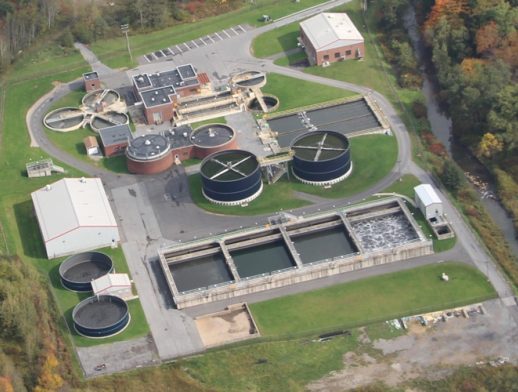Wastewater Treatment Plant

Address
282 State St.
St. Marys, PA 15857
Phone
(814) 834-6650
Business Hours
Monday - Friday
7:30 A.M. - 4:00 P.M.
NARRATIVE
The St. Marys Wastewater Treatment Plant has been in operation since 1961. It is staffed with five certified operators, one laborer, one part time lab technician, and three sewer system technicians. The Wastewater Treatment Plant treats all of the sanitary sewage and a portion of the industrial wastewaters generated within the City of St. Marys. The facility provides treatment by means of a trickling filter/activated sludge process. The residual solids produced at the plant are anaerobically digested.
When the wastewater treatment plant started operation in June, 1961, the hydraulic capacity of the plant was 1.36 million gallons per day. The plant was re-rated in 1972 to a hydraulic capacity of 2.0 million gallons per day. The St. Marys Wastewater Treatment Plant was expanded to its present capacity in 1986-88. The treatment plant allows for an average daily flow of 2.87 million gallons per day and wet weather flow of 7.87 million gallons per day. The suspended solids, organic loadings, and ammonia nitrogen loadings for the St. Marys Wastewater Treatment Plant are 5,076 pounds, 4,303 pounds, and 698 pounds respectfully. The population equivalence for the wastewater treatment plant is 17,000 people.
WASTEWATER COLLECTION SYSTEM
The sanitary sewer system that conveys the wastewater to the St. Marys Wastewater Treatment Plant consists of approximately 68.40 miles of sewer line. The sanitary sewer line varies in size from four inches to 20 inches in size. There are two lift stations that the City of St. Marys maintains. These lift stations are located on West Creek Road in the Industrial Park and on Ridgway Road approximately 3/4 of a mile west of the Treatment Plant.
WASTERWATER TREATMENT PLANT
The sewage treatment process consists of directing the raw sewage flow through screening and grit chambers. Screenings and grit are removed from the flow and deposited in containers for later transport to the landfill.
From the grit chamber, flow enters the grinder room where any solids that pass through the screens are shredded. The flow enters three primary sedimentation tanks via a flow distribution box. The heavier solids in the wastewater settle to the bottom and are removed to the sludge thickener. The effluent from the primary tanks is directed to two trickling filter towers. Effluent from the towers is sent to the aeration tanks where air is added. From the aeration tanks, the wastewater flows to the final clarifiers. Effluent from the final clarifiers is chlorinated and discharged to Elk Creek.
The activated sludge that settles out in the final tanks is drawn off, a percentage of this sludge is returned to the head end of the aeration tanks and mixed with the incoming sewage. A smaller portion of this activated sludge is wasted to the sludge thickener. Thickened sludge is pumped to the primary anaerobic digester where it undergoes decomposition before it is transferred to a secondary anaerobic digester for further decomposition. The supernatant from the secondary digester is directed to the grit chamber where it mixes with the incoming raw sewage.
Digested sludge from the secondary digester is pumped to the belt filter press. The belt filter press dewaters the sludge and the filter cake is hauled to the landfill for disposal.
PRETREATMENT PROGRAM
The St. Marys Wastewater Treatment Plant operates an EPA approved pretreatment program in the City of St. Marys. Currently, there are 17 significant industrial users and four non-significant industrial users whose discharge of industrial wastewater to the treatment plant is regulated. This program has been in operation since 1984.
